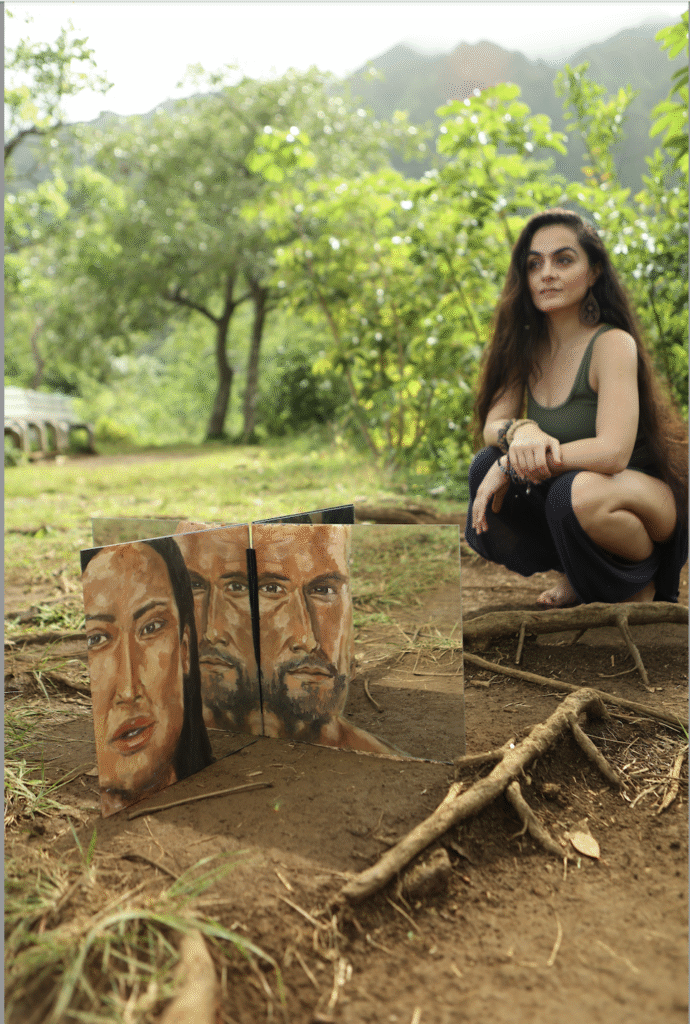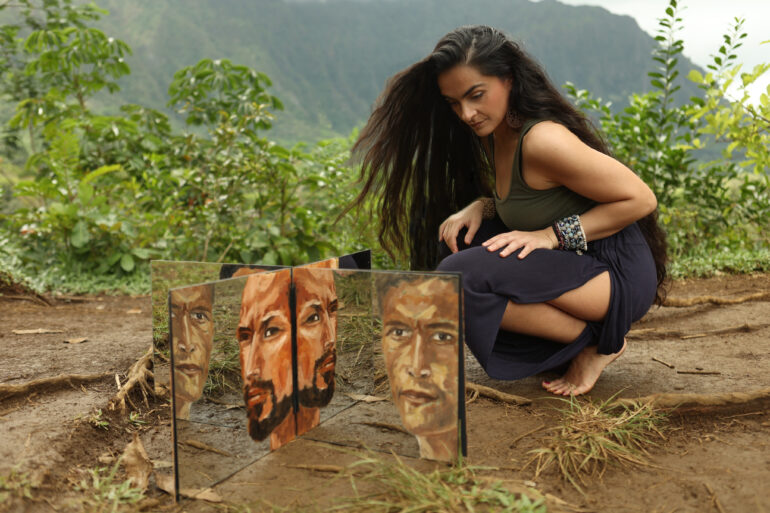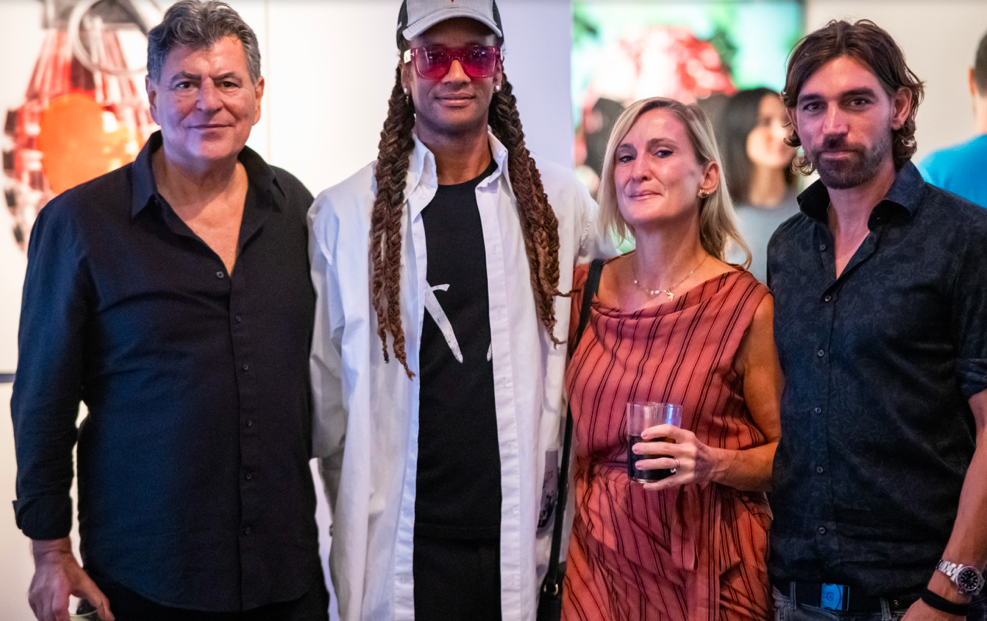Samara Couri’s work is a portal—one that invites viewers to step into intimate, layered realms of reflection, both literal and emotional. Born in London and now based in Honolulu, Hawai‘i, Couri is an artist whose practice is as much about connection as it is about perception. Known for her figurative paintings that often blur the boundaries between self and other, Couri uses not only traditional canvas but also mirrors to build immersive visual worlds. These mirrored works do more than reflect—they engage, refract, and reshape perspective, positioning the viewer as an active participant in a constantly shifting psychological space.
Currently, Couri is working on a powerful new project rooted in Hawai‘i’s cultural landscape. Collaborating with esteemed cultural practitioners such as Kumu A‘ia‘i Bello and grassroots organizations like Ka Lāhui Hawai‘i, Couri is exploring the concept of the Akua—divine beings in Hawaiian cosmology—through contemporary figurative painting. This evolving body of work draws from ancestral knowledge and place-based storytelling, creating a dialogue between tradition and transformation.
In this conversation, Culturalee talks to Couri about her artistic evolution, the role of collaboration and community in her work, and how living in Hawai‘i has reshaped her understanding of the sacred, the self, and the spaces in between.
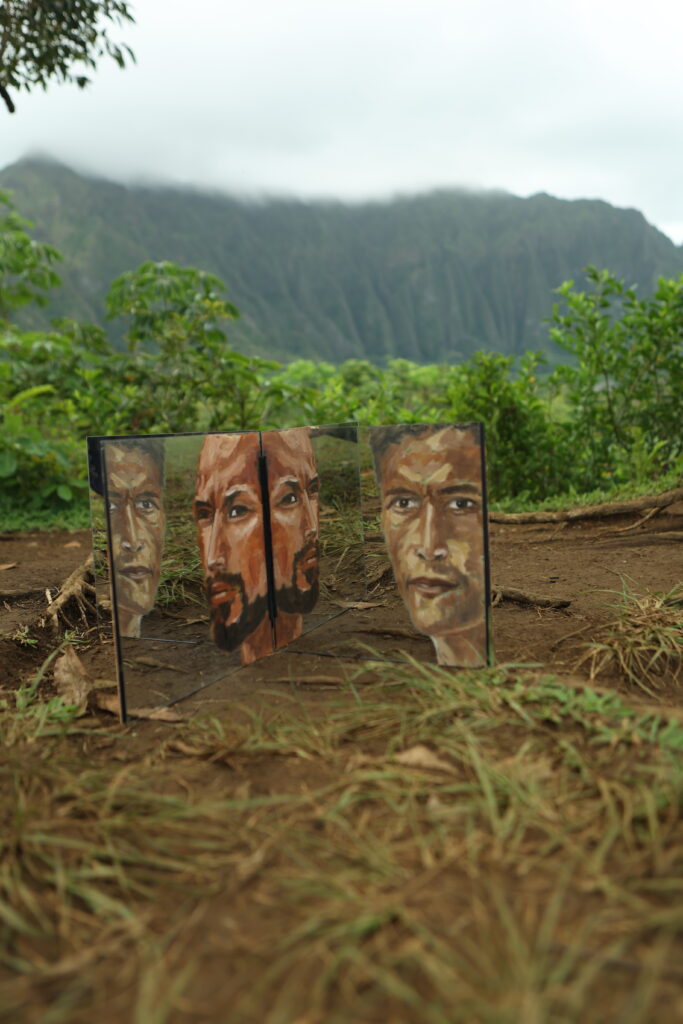
Your paintings on mirrors do more than depict, they quite literally reflect. What first drew you to using mirrors as both medium and metaphor in your work?
My inspiration to work with mirrors stems from my fascination with film. I love how viewers can become absorbed in a scene or a moment between characters—how we sometimes resonate with the story or see different perspectives. Film is a medium of movement, and I sought that immersive experience in my art. One day, as I was reflecting on this, I looked up at a mirror on my wall, took it down, and started painting on it. It was then that everything clicked. Mirrors provide an experience of creating a scene and inviting viewers to become part of it, one way or another.
How has living in Hawai’i shaped your understanding of observation and empathy, especially in the way your work involves the viewer directly as part of the subject?
Living in Hawai’i has awakened a deep consciousness in me about the islands’ history, which informs much of my work. The Kingdom of Hawai’i was overthrown and illegally taken. This history remains central to many Kanaka Maoli (Indigenous peoples of Hawai’i), who strive to have their voices heard and their culture and language preserved after years of suppression. For me, being here means being mindful of this legacy and engaging however I can—through learning the language, hula, oli (chant), and more—to show respect and help ensure these traditions are not forgotten, and that sovereignty remains a possibility. Hawaii’s rich and profound culture is deeply moving, making it impossible not to connect. Therefore, my work reflects my care for the islands, its people, their beliefs, and their causes. Living here is not just about oneself but about truly connecting and opening up that world, hence involving the viewer directly in the subject.
Your current project explores the Hawaiian Akua as reflections of nature and life cycles. How do you approach translating such profound cultural knowledge into your visual language?
Each Akua represents a natural element or action: fire, rain, forest, and so on. In my paintings, I personify them into figures incorporating their respective elements. These Akua connect with one another, sometimes closely or as polar opposites like fire and snow. Each piece forms part of a pair: two mirrors facing each other, each painted with an Akua. Their interaction reflects connections between the Akua and us as people. Since the Akua, embodying nature, give us life, we must give back to sustain all forms of life. This creates an immersive experience inviting the viewer into the world of the Akua to understand their vital roles and our responsibilities as humans.
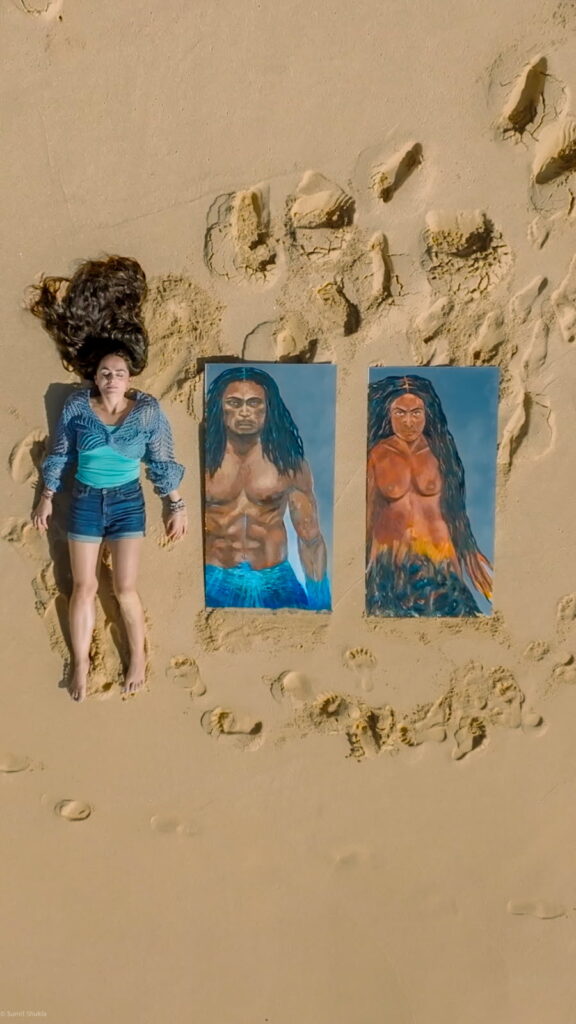
You’re collaborating with Kumu A’ia’i Bello and organizations like Ka Lāhui Hawai‘i. What has the process of working with cultural practitioners and grassroots groups taught you about responsibility and representation in art?
This collaboration has been essential to my work. It has opened a vast world of learning about the islands’ ways of life, beliefs, and spirituality, especially the ongoing fight for self- governance and self-determination championed by grassroots group Ka Lāhui Hawai’i. They tirelessly address critical issues in Hawai’i, such as environmental disasters caused by the U.S. Navy—most notably the Red Hill water crisis—and organize protests to prevent the exploitation of sacred lands like Mt. Ka’ala, which is under threat from plans to build tourist attractions like gondola zip lines. These ventures prioritize profit over the wellbeing of Indigenous people and the land, which holds deep sacred and historical significance. With so much land and rights already lost, the greed from outsiders seems limitless. It’s vital to educate oneself about these realities and not treat the islands as a playground. These are serious issues that Hawaiians face daily while fighting to protect their home under difficult circumstances. For those interested, please visit www.kalahuihawaii.net to learn more and support their cause.
Working closely with Kumu ‘A’ai’i—a Hawaiian Cultural Practitioner, a Kumu Hula (Hula teacher), and Kapa Maker amongst many other gifts she has and does—has deeply enriched my understanding of the islands’ philosophies, culture, and history, especially the true meaning of Akua and the interconnectedness of all things. She is also my oli (chant) teacher, guiding me through the powerful and precise art of chanting, where vibration, pronunciation, and execution are critically important. There is a chant for almost everything, further reinforcing connection. I feel I’ve only begun to scratch the surface of this knowledge, which is deeply rooted in the people, and I am committed to continually learning and faithfully representing these emotions and studies in my work.
Mirrors often raise questions about identity, perception, and self-awareness. Do you see your work as inviting introspection in the viewer—and if so, what do you hope they discover?
Absolutely. I invite introspection by creating spaces where viewers feel safe to connect in their own way. In many ways, the pieces become theirs in that moment—open to personal interpretation, feelings, and thoughts about what may unfold. This immersive experience between viewer and artwork creates a unique connection and layers of meaning. It might remain a private dialogue or become something they share with others, perhaps opening an entirely new world they hadn’t noticed before.
Coming from London and now living in Honolulu, how do you navigate your position as a guest on the islands in creating work that engages deeply with local culture and cosmology?
The key word is “guest,” and I appreciate you using it because it’s crucial to acknowledge, especially given the islands’ history. As a guest, I strive to learn as much as possible and actively engage in cultural practices, whether through dance, oli (chant), or volunteering in beach clean-ups. This ongoing learning is important because my work focuses on Hawai’i and its people as a form of giving back and showing respect. I deeply empathize with their causes. Hawai’i is a sacred and special place, and it’s essential to genuinely honor my role within it.
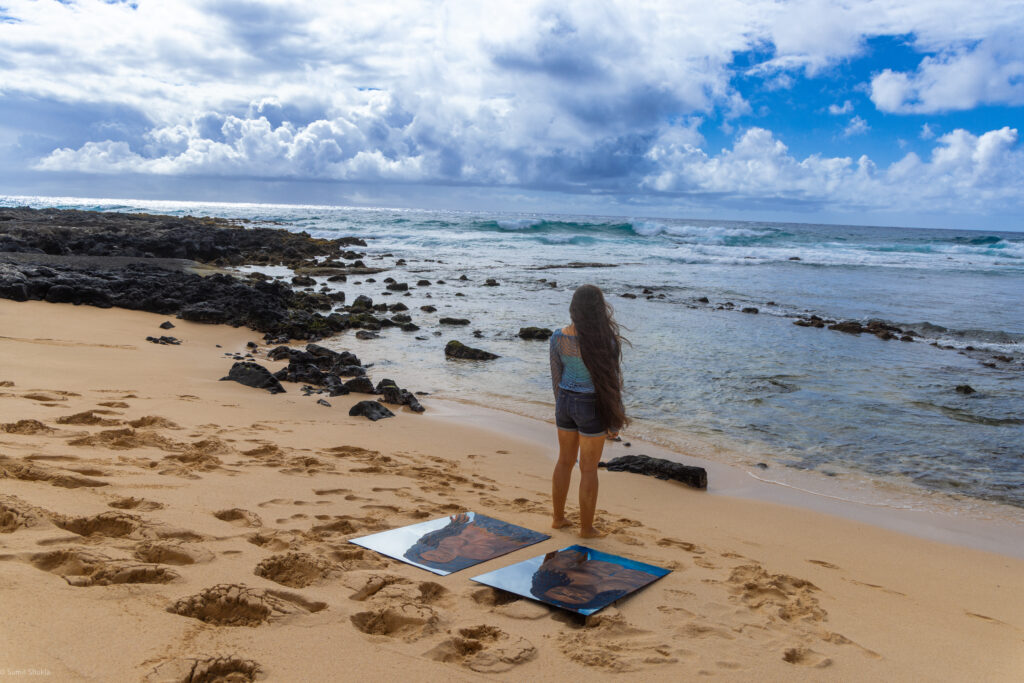
Your figures often appear ethereal or fragmented due to the reflective surface. What does this visual instability say about the nature of identity or presence in your work?
It reflects the ever-changing nature of identity—there’s always something new to discover and learn about ourselves and others. This awareness calls for openness to whatever we encounter, while also recognizing that change can happen at any moment, and we have the free will to respond. If you catch something in your reflection within the pieces, what will you do with it? Will you explore it further or leave it behind? Perhaps it becomes a tool for healing and prepares you for personal transformation. Often, it’s the subtle aspects of identity that make the greatest impact.
How do you balance storytelling and abstraction in your pieces, especially when referencing spiritual and ecological narratives rooted in Hawaiian traditions?
This requires careful thought, particularly regarding the Akua. I choose to incorporate their elemental qualities into personified figures, enabling viewers to identify and connect with each Akua. Additionally, the pairing of figures deepens the narrative through their mo’olelo (story/history). Every brushstroke and element carries meaning, contributing to what each piece seeks to express and explore.
There’s a layered experience in viewing your work—seeing the figure, the environment, and oneself all at once. How do you think this simultaneity alters the way people engage with your art?
It is undoubtedly an immersive experience, one I hope viewers find engaging and exciting as they explore multiple physical perspectives and angles. This dynamic interaction often introduces a psychological dimension, prompting viewers to become aware of their own presence and thoughts in relation to the work.
What’s next for your practice—are there other materials, cultural partnerships, or themes you’re interested in exploring as your work continues to evolve?
My focus typically shifts based on my environment. Currently, I continue to explore Hawai’i but may expand to other Polynesian islands and regions. I’m also creating more abstract works centered on the Kanaka Maoli (Indigenous people), featuring loose, expressive brushstrokes on smaller mirrors in different compositions. These compositions highlight the pressing issue of many Hawaiians being unable to live on their ancestral lands due to severe economic injustices, emphasizing their enduring connection and the urgent need for change. This evolving subject matter is a current focus, and I remain open to where the process may lead. Often, my work evolves quite organically.
